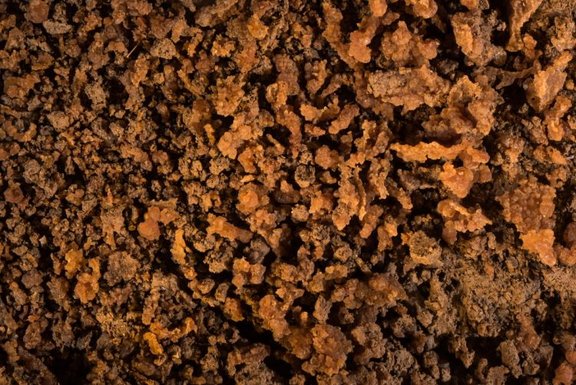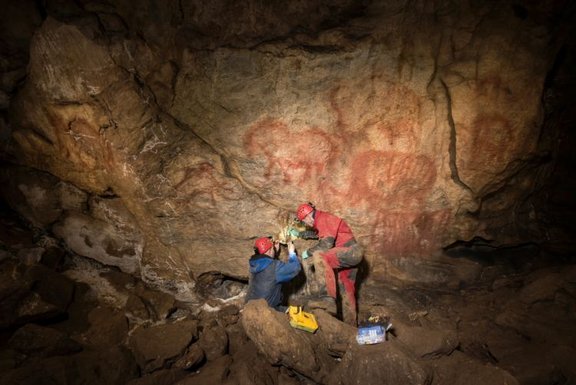Painting inside a freezer
The geologist Yuri Dublyansky from the University of Innsbruck used state-of-the-art methods to investigate Palaeolithic cave paintings in the Shulgan-Tash Cave in Russia. Prehistoric people visited and painted in this cave despite very inhospitable interior conditions. The results of the study were recently published in the scientific journal "Scientific Reports".
Report by Melanie Bartos
Office of Public Relations of the University of Innsbruck, October 2018
Photos: Robbie Shone
The Shulgan-Tash Nature Reserve in the southern Ural Mountains of Russia stretches across more than 200 square kilometers. The area is known for its untouched nature and the occurrence of protected plants and animal species, as well as for a large cave system. In the middle of the 20th century, Palaeolithic cave paintings were discovered in the Shulgan-Tash cave - a sensation from an archaeological point of view.
The Shulgan-Tash cave is the easternmost occurrence of Paleolithic cave paintings in Europe.
Before this discovery it was assumed that the famous cave paintings in northern Spain and southern France were the only ones of their kind in the Palaeolithic. The Ural cave is 4000 kilometers away and is the easternmost occurrence of cave paintings from the Palaeolithic period in Europe.
Map: The Shulgan-Tash Nature Reserve is located in the Southern Ural Mountains.
Audio: Yuri Dublyansky explains the challenges of working in the cave.
In autumn 2017, Dr. Yuri Dublyansky from the Institute of Geology at the University of Innsbruck, together with a team of experts and professional cave photographer Robbie Shone, made his way to Russia to investigate the cave paintings in the Shulgan-Tash (also known as Kapova) cave.
"The cave has already been well researched archaeologically. The paintings have been dated to between 16,000 and almost 20,000 years using the radiocarbon method, but these analyses were performed on finds from archaeological excavations in the cave and not directly on the paintings," explains Yuri Dublyansky. The aim of the team was now to determine the age of the cave paintings with another, independent method.
They painted mammoths, horses, woolly rhinoceros, bisons and numerous geometric forms.
The paintings in the Shulgan-Tash cave show mammoths, horses, woolly rhinoceros, bisons and numerous geometric forms such as parallel lines or triangles. The paintings are dark red and were made with ochre. In 2017 Russian scientists also found a picture of a Bactrian camel: at the time the drawings were made, however, there were no camels living in the area. Experts therefore believe that the people of that time had already covered longer distances than were previously thought.
22 locations in three halls of the cave
With the help of physical methods such as the Thorium-Uranium method, the researchers can constrain the age of the paintings by accurately dating the mineral deposits underneath and above the drawings. This method has already been used by the Innsbruck team in many projects and allows dating deposits in caves back to hundreds of thousands of years.
We proceeded very carefully, because it is important to us that the valuable paintings do not suffer any damage. Only tiny amounts of the mineral deposits had to be carefully removed for analysis in the laboratory.
Yuri Dublyansky
Yuri Dublyansky took samples at 22 locations in three halls of the cave.
Mysterious gap
"We took samples from the deposits above and below the cave paintings and determined their age. The oldest layer is about 36,000 years old and the youngest about 14,500 years," says Dublyansky. "This results in a gap of about 20,000 years, during which the paintings were made. This break in the formation of deposits in the cave suggests that no water was present in the cave over this period of time." The reason for this dryness was discovered when researchers found a rare type of calcite called cryogenic cave calcite in the cave. This mineral forms in very slowly freezing water pools filling the cave, which are only possible when the area is in the permafrost zone.

Yuri Dublyansky is collecting the cryogenic cave calcite.

Rare cryogenic cave calcite was found in the cave.
"At the time when the prehistoric people came into the cave and made the drawings, permafrost must have prevailed in Southern Ural," explains the geologist.
Temperatures in the cave have been permanently below the freezing point.
This is a surprising finding, as it must have been quite uncomfortable in the cave: "Our analyses have shown that the temperatures in the cave have been permanently below the freezing point both in summer and in winter - and over a very long period of time. Yet, the people went into the cave and made the drawings with ochre. We therefore assume that the cave must have been a special, perhaps spiritual place for these Stone Age people."

Link to the paper (Open Access):
https://www.nature.com/articles/s41598-018-30049-w
© University of Innsbruck, October 2018
Text and audio:
Melanie Bartos
Photos:
Robbie Shone

